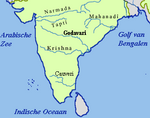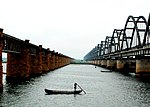Nizam's Guaranteed State Railway
 The Hyderabad State | |
| Overview | |
|---|---|
| Headquarters | Secunderabad Station (1870-1916) Kachiguda Station(1916-1950) |
| Locale | Telangana, India (consists of former states Hyderabad State and Madras Presidency) |
| Dates of operation | 1870 (1879 fully owned by Nizam)–1950 (nationalized by government of India under Indian Railways) |
| Successor | Central Railway(1951) South Central Railway(1966) |
| Technical | |
| Track gauge | Mixed |
| Length | 351 miles (1905) 688 miles (1943) |
Nizam's Guaranteed State Railway (NGSR) was a Railway Company in India between 1879 and 1950, and was owned by the Nizams of Kingdom of Hyderabad. The full style of the system was His Exalted Highness, The Nizam's Guaranteed State Railway which had its beginnings in a line built privately by the HEH the Nizam, much to the dismay of the British authorities. It was owned and worked by a company under a guarantee from the Hyderabad State, capital for which was raised by the issue of redeemable mortgage debentures. In 1951 the NGSR was nationalised and merged into Indian Railways.
History


Being one of the largest princely states of India, the 6th Nizam of Hyderabad wanted to build a railway line to connect Hyderabad with the rest of the British India (now India). The proposal was for an initial railway line from Secunderabad Railway Station in Hyderabad to Wadi Junction, whose construction expenses the Nizam agreed to underwrite.[1] Subsequent branches were financed through a variety of means. Construction commenced in 1870, and the Secunderabad-Wadi Line was completed in four years. Later from 1874 to 1889, this line was extended to Kazipet and then Vijayawada.
In 1879, the Nizam of Hyderabad Mahbub Ali Khan, Asaf Jah VI took direct control of the company, integrating it into the state bureaucracy as the state-owned Nizam's Guaranteed State Railway.[2][3] But this partial nationalization was reversed in 1883, when a management company was formed to gradually take over these lines, under the provision of a guarantee from the Government of HEH the Nizam of Hyderabad State. In 1899, the broad gauge connection between Bezwada (Vijayawada) and Madras (Chennai Central) opened making rail travel between Hyderabad and Chennai possible. The State thus contained 467 miles on the broad gauge, all built before 1891, and 391 miles on the metre gauge, opened between 1899 and 1901.
The total capital expenditure on the Nizam's State Railway to the end of 1904 was 4.3 crores, and in that year the net earnings were nearly 28 lakhs, or about 61⁄2 percent on the outlay.
In 1916, another railway terminus, Kachiguda Railway Station, was built to serve as the railway's headquarters.[4]
The Nizam's railway was divided into various, directly-owned subcorporations. Each had a head official appointed the Nizam's Railway. The profits of these rail lines were enjoyed by it.
'Nizam’s Guaranteed State Railway' Lines (1883-1930)
Below were the constituent lines within the Nizam's Railway:[5]
- Bezwada Extension (34.5 miles) opened in 1889
- Belharshah-Kazipet (234.5 miles) opened in 1924
- Karipalli-Kothagudam (39.5 miles) opened in 1927
- Vikarabad-Bidar (91 miles) opened in 1930
- Purna Junction-Hingoli (miles) opened in 1912
- Secunderabad-British Frontier (188.2 miles) opened in 1916
- Dhone Kurnool (cont. to Madras) (58.5 miles) opened in 1909.
- The Singareni coal fields were served by a branch line from Dornakal Junction, a distance of 30 km.[6]
Hyderabad-Godavari Valley Railways
The Nizam's railway also consolidated with a separate railroad, the Hyderabad-Godavari Valley Railway.
The Hyderabad-Godavari Valley railway was chartered to build a metre-gauge line between its namesake regions. In 1896, it appointed John Wallace Pringle as the superintending engineer for survey and construction, fresh from surveying routes for the Uganda railway.[7] Four years later, the railway began service on the 391 miles (629 km) from Hyderabad city to Manmad Junction.
The Hyderabad-Godavari Valley Railways has cost 2.6 crores, and earned 7.7 lakhs net in the same year, or nearly 3 percent; but in 1901 and 1902 the earnings had been about 31⁄2 percent.
The cotton industry and the railways
In the early twentieth century, cotton being the largest export of Hyderabad State, the cotton industry held an important place in the eyes of Nizam's Hyderabad Government. In 1889 a cotton spinning mill and weaving mill were erected in Aurangabad city, which employed 700 people. With the opening of the Hyderabad–Godavari Valley Railways in the year 1900 several ginning factories were started. In the Jalna alone there were 9 cotton ginning factories and five cotton presses, besides two ginning factories at Aurangabad and Kannad, and one oil press at Aurangabad. The total number of people employed in the cotton presses and ginning factories in the year 1901 was 1,016.
The area of cultivated land under cotton in 1914 was three million acres (12,000 km²), and most of the cotton was grown in the Marathwada districts, where the soil was peculiarly well suited to it.[8]
The opening of the Hyderabad–Godavari Railway, in October 1900, gave a great impetus to the growth of cotton in the Nizamabad, Nander, Parbhani and Aurangabad Districts, where many ginning and pressing factories came into existence as soon as heavy machinery could be brought there by rail. Bombay buyers then began to arrive in considerable numbers during the cotton season, which lasted from October to December, and as they paid cash for the cotton and would even send coolies to cut it and bring it to the cotton marts, more and more land began to be put down in cotton by the farmers. Hand gins gave place to ginning machines, and the farmers ce ased to weed their fields carefully, and to cultivate only the best cotton. Grain and pulses then became more expensive, so much of the best land being laid down in cotton, and Marathwada entered upon a critical period of its existence.[8]
Says the census report of the period: " The evolution from the agricultural to the manufacturing stage has already begun in Marathwara When a country begins to produce the raw materials of manufacture in place of food crops, it has started on the road to industrialisation." There were three large spinning and weaving mills and about 90 small ginning and pressing factories in the State. The population supported by cotton spinning, sizing, and weaving in 1914 was 69,943 persons and by cotton ginning, cleaning, and pressing was 517,750 persons. The wages paid to the employees in these places were good, but the cost of living in Marathwara was very high, owing to the many holdings that are put down in cotton, and the uncertainty of the rainfall and availability of credit form money lenders.[9]
Under the Rail and Road Transport Department
Beginning in 1932 scheduled bus services – under the auspices of the railway administration – began over 450 km with 27 vehicles. Within a decade, at a total expense of 7½ million HRs. This was extended to nearly 500 vehicles, servicing 7200 km. To coordinate transport policies, the Nizam's State developed a unified Rail and Road Transport Department. According to historian M.A. Nayeem, The functioning of the railways, roadways and airways under a single department was unique in the world."[10] As a result, post-1948, Hyderabad State (later which became Andhra Pradesh) had a significantly superior bus network compared to the rest of India. Other Indian states such as Madhya Pradesh even bought used buses of Andhra Pradesh without hesitation. A four-lane highway which has now replaced the Nizam-era road from Hyderabad to North India.[11]
Modern legacy
In 1950, the NGSR was nationalised and in 1951 became part of Central Railway, a zone of Indian Railways.[12]
The metre-gauge lines were converted to 1,676 mm (5 ft 6 in) broad gauge from 1992 to 2004.[13]
See also
- Deccan Queen (bus)
- Cyril Lloyd Jones
- Establishments of the Nizams
- Mir Osman Ali Khan
- 6th Nizam- Mir Mahbub Ali Khan
References
- ^ Law 1914, pp. 26–28.
- ^ "HH the Nizam's Railway, Poosapally gorge". bl.uk. Retrieved 10 July 2020.
- ^ Lynton & Rajan 1987, pp. 56–57.
- ^ Umashankar, JBS (27 April 2013). "Nizam was way ahead of his time". Deccan Herald. Retrieved 10 July 2020.
- ^ Sivaramakrishnan, R (18 August 2008). "'Hyderabad' by Mirza Mehdy Khan in the Provincial Series of the Imperial Gazetteer of India, Government Printing Press, Calcutta, 1909". Indian Railways Fan Club [IRFCA]. Retrieved 28 April 2019.
{{cite web}}: Invalid|ref=harv(help) - ^ Jaganath, Dr Santosh. The History of Nizam's Railways System. Lulu.com. ISBN 978-1-312-49647-7. Retrieved 10 July 2020.
- ^ "Inspecting Officers (Railways) – Pringle, (Sir) John Wallace". SteamIndex. Retrieved 10 July 2011.
- ^ a b "Hyderabad Godavari Valley Railway: Buldana, Aurangabad & Parbhanai Districts, Sheet No.56 A/N.W - Unknown". Google Arts & Culture. Retrieved 14 July 2020.
- ^ J, Nikhil (29 November 2018). "Hyderabad–Godavari Valley Railway and Cotton Industry". CityKatta.
- ^ Nayeem 2002, p. 221.
- ^ Subani, Hamad (28 June 2016). "The Secret History of Hyderabad State of the Nizam (1724-1948)". Cabal Times. p. 12. Archived from the original on 28 April 2019. Retrieved 28 April 2019.
- ^ Ifthekar, JS (26 November 2017). "The wheel comes full circle…: A look back at the history of transportation in the city". Telangana Today.
- ^ "Last MG train pulls out of Nizamabad station". The Hindu. 1 July 2004.
Further reading
- Khān, Mirza Mehdy; Vredenburg, E.; Prain, C. I. E. (1909). Hyderābād State. Imperial Gazetteer of India: Provincial Series. Calcutta: Government Printing Office.
{{cite book}}: Invalid|ref=harv(help) - Law, John (1914). Modern Hyderabad (Deccan). Calcutta: Thacker, Spink, & Co.
{{cite book}}: Invalid|ref=harv(help) - Lynton, Harriet Ronken; Rajan, Mohini (1987). The Days of the Beloved. Berkeley: University of California Press. ISBN 0520024427.
{{cite book}}: Invalid|ref=harv(help) - Nayeem, M. A. (2002) [1987]. The Splendour of Hyderabad: the last phase of an oriental culture, 1591-1948 A.D. (Revised ed.). Hyderabad: Hyderabad Publishers. ISBN 8185492204.
{{cite book}}: Invalid|ref=harv(help)
- Metre gauge railways in India
- Defunct railway companies of India
- Secunderabad railway division
- Hyderabad State
- South Central Railway Zone
- Transport in Aurangabad, Maharashtra
- Rail transport in Maharashtra
- Transport in Hyderabad, India
- Establishments in Hyderabad State
- Railway companies disestablished in 1951






